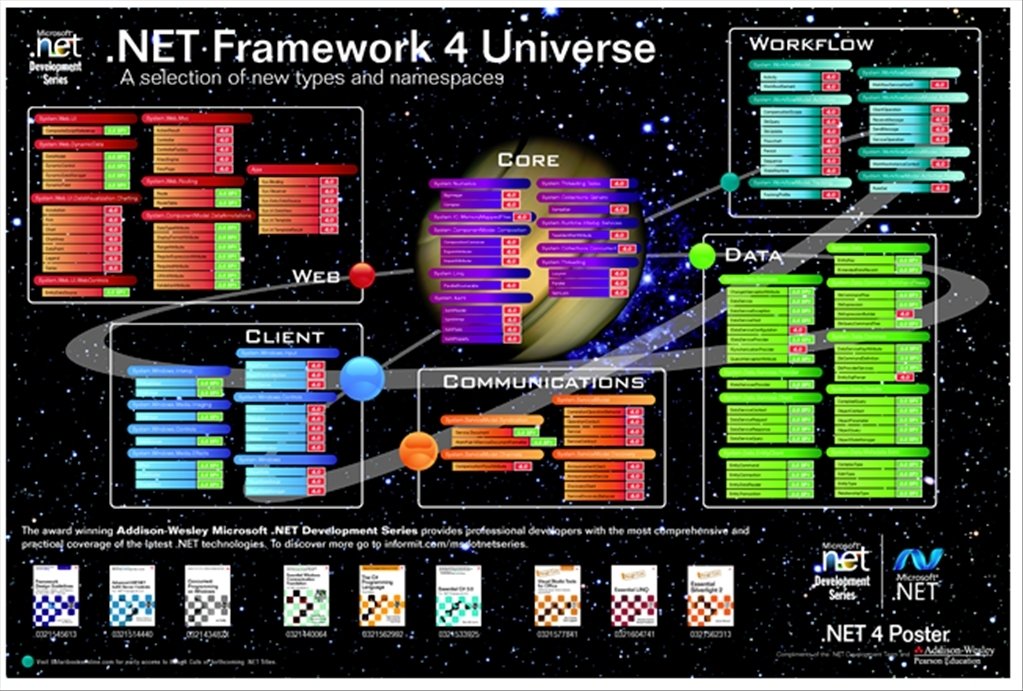Consistent programming model: The .NET Framework provides a common object-oriented programming model across languages. This object model can be used in code to perform several tasks, such as reading from and writing to files, connecting to databases, and retrieving data.
Multi-platform applications: There are several versions of Windows most of which run on x86 CPUs. Some versions, such as Windows CE and 64-bit Windows, run on non-x86 CPUs as well. A .NET application can execute on any architecture that is supported by the CLR. In future, a CLR version could even be built for non-Windows platforms.
Multi-language integration: .NET allows multiple languages to be integrated. For example, it is possible to create a class in Visual C# that derives from a class implemented in Visual Basic. To enable objects to interact with each other regardless of the language used to develop them, a set of language features has been defined in Common Language Specification (CLS). This specification includes the basic language features required by many applications. The CLS enhances language interoperability. The CLS also establishes certain requirements, which help you to determine whether your managed code conforms to the CLS. Most of the classes defined in the .NET Framework class library are CLS-compliant.
Automatic resource management: While creating an application, a programmer may be required to write code for managing resources such as files, memory, network connections, and database resources. If a programmer does not free these resources, the application may not execute properly. The CLR automatically tracks resource usage and relieves a programmer of the task of manual resource management.
Ease of deployment: One of the goals of the .NET Framework is to simplify application deployment. .NET applications can be deployed simply by copying files to the target computer. Deployment of components has also been simplified. Till now, Microsoft’s Component Object Model (COM) has been used for creating components. COM suffers from various problems relating to deployment. For example, every COM component needs to be registered before it can be used in an application. Moreover, two versions of a component cannot run side-by-side. In such a case, if you install a new application that installs the newer version of the component, the newly installed application may function normally. However, the existing applications that depend on the earlier version of the component may stop functioning.
As against this, the .NET Framework provides zero-impact deployment. Installation of new applications or components does not have an adverse effect on the existing applications. In the .NET Framework, applications are deployed in the form of assemblies. An assembly stores metadata. Therefore, registry entries are not required for storing information about components and applications. In addition, assemblies also store information about the versions of components used by an application. Therefore, the problems relating to versioning are also eliminated in the .NET Framework.
.NET Framework versions available
.NET Framework 1.0
The first version of the .NET Framework was released in January of the year 2002.
.NET Framework 1.1
Version 1.1 is the first major revision of the Framework; including the following changes:
- Built-in support for mobile ASP.NET controls. Previously available as an add-on for .NET Framework 1.0, now part of the framework.
- Security changes - enable Windows Forms assemblies to execute in a semi-trusted manner from the Internet, and enable code access security in ASP.NET applications.
- Built-in support for ODBC and Oracle databases. Previously available as an add-on for .NET Framework 1.0, now part of the framework.
- .NET Compact Framework - A version of .NET Framework for mobile devices; such as Microsoft Windows CE
- IPv6 support.
.NET Framework 2.0
Introducing a major change in the Framework, the version 2.0 has the following changes:
- New API features
- Programming support for x86_64 processor architechtures.
.NET Framework 3.0
The new version of .NET Framework, previously called WinFX is a fundemental part of Windows Vista and is available on Windows XP.
The Framework contains four major new features:
- WPF - Windows Presentation Foundation, codenamed Avalon
- WCF - Windows Communication Foundation, codenamed Indigo
- WF - Windows Workflow Foundation
- WCS - Windows CardSpace, codenamed InfoCard
.NET Framework 3.5
The 3.5 version of the .NET Framework is the release of .NET Framework after version 3, adding a few new features and improvements, such as improvements to the C# language (3.0 specification), and VB.NET compiler.
.NET Framework 4.0
.NET 4.0 is the current release of the .NET framework, launched alongside Visual Studio 2010, including new features, such as language features for Visual Basic .NET and C#, and improvements, such as Parallel Extensions to improve support for parallel computing.





 My name is Jakfar Zakaria. My friends call me Jakfar. I have lived such a tiring journey, about my education and others. Four years ago, I explore the computer network specializes in Linux Technology. And now I steeped about computer programming. I have little ability in computer programming, I focus on Visual Basic .NET programming language and PHP programming language. It takes a big sacrifice in studying it all, and my teacher is Google! Yups, Google! Google is a good teacher for me.
My name is Jakfar Zakaria. My friends call me Jakfar. I have lived such a tiring journey, about my education and others. Four years ago, I explore the computer network specializes in Linux Technology. And now I steeped about computer programming. I have little ability in computer programming, I focus on Visual Basic .NET programming language and PHP programming language. It takes a big sacrifice in studying it all, and my teacher is Google! Yups, Google! Google is a good teacher for me.
No comments:
Post a Comment